DBMandrake
Well-known member
For the last year I've been keeping an eye on my Ion's Ah battery capacity using Diagbox, and there has been a gradual steady, linear decline of capacity that has been in line with or better than other similar mileage cars. Until today my last measurement was in January.
I recently got hold of an Android tablet and have had an OBDLink LX on order for about a week so I can more easily monitor the battery and general functioning of the car. It hasn't arrived yet but should do this week.
As I haven't checked the Ah figure for 3 months with Diagbox I thought I would today, before my adaptor for Canion arrived - I kind of wish I hadn't! :x There has been a steep decline in reported capacity since January:

The last reading in January was 38.9Ah now in April 3 months and about 3000 miles later it is 37.6Ah. Prior to this it was dropping about 0.1Ah per 1000 miles, now it has dropped 1.3Ah in 3 months...
While the battery was at about 4 bars I checked the cell voltages - which is a lot more cumbersome than using Canion, I did find Cell A in group 4 was averaging 10-15mV less than it's neighbour cells:
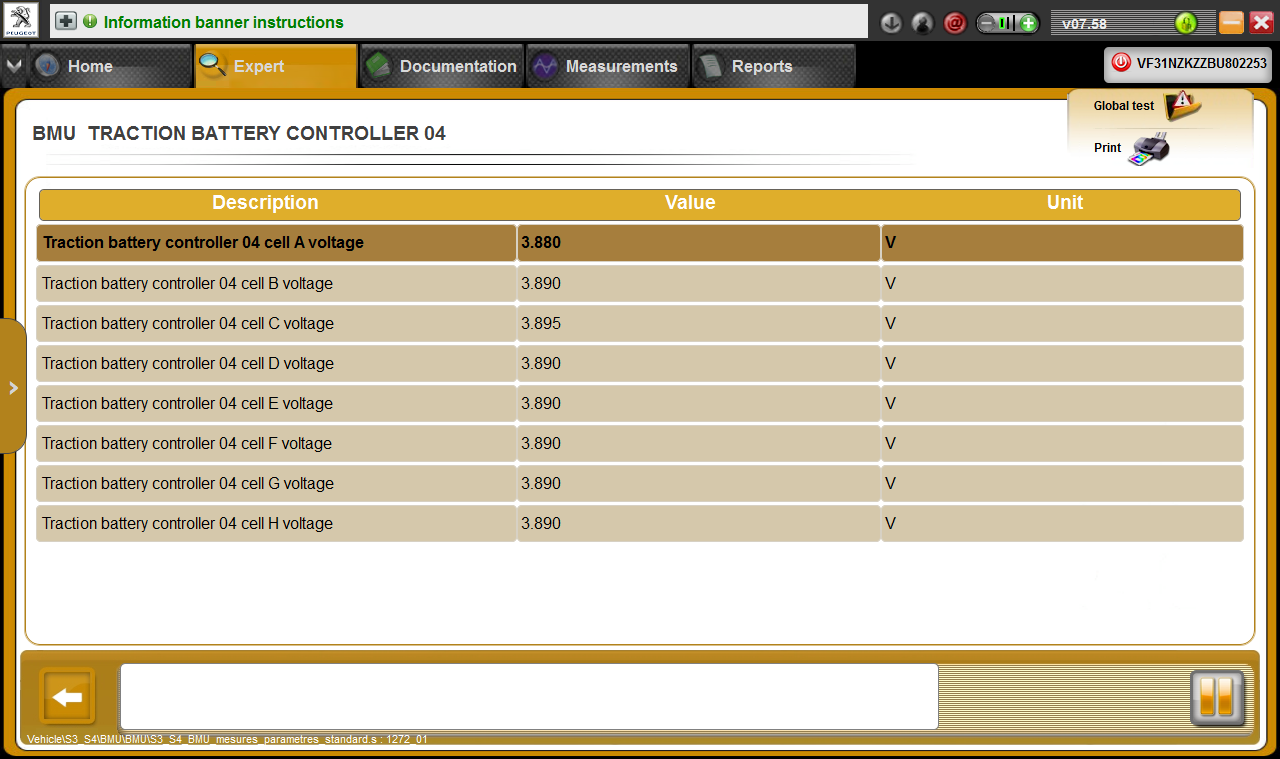
During charging this difference went away as the battery got above 50% or so. I didn't notice any other obvious imbalances in other groups. Obviously any cell imbalances at different states of charge will be much easier to see on Canion's graph so its rather fortuitous that I will have that up and running soon.
I decided that now might be the time to try the battery calibration process in Diagbox. The process is a rather byzantine, manual process compared to the one I've seen described for the MUT tester, here are some of the screens from it during the process, which took over 12 hours in total:

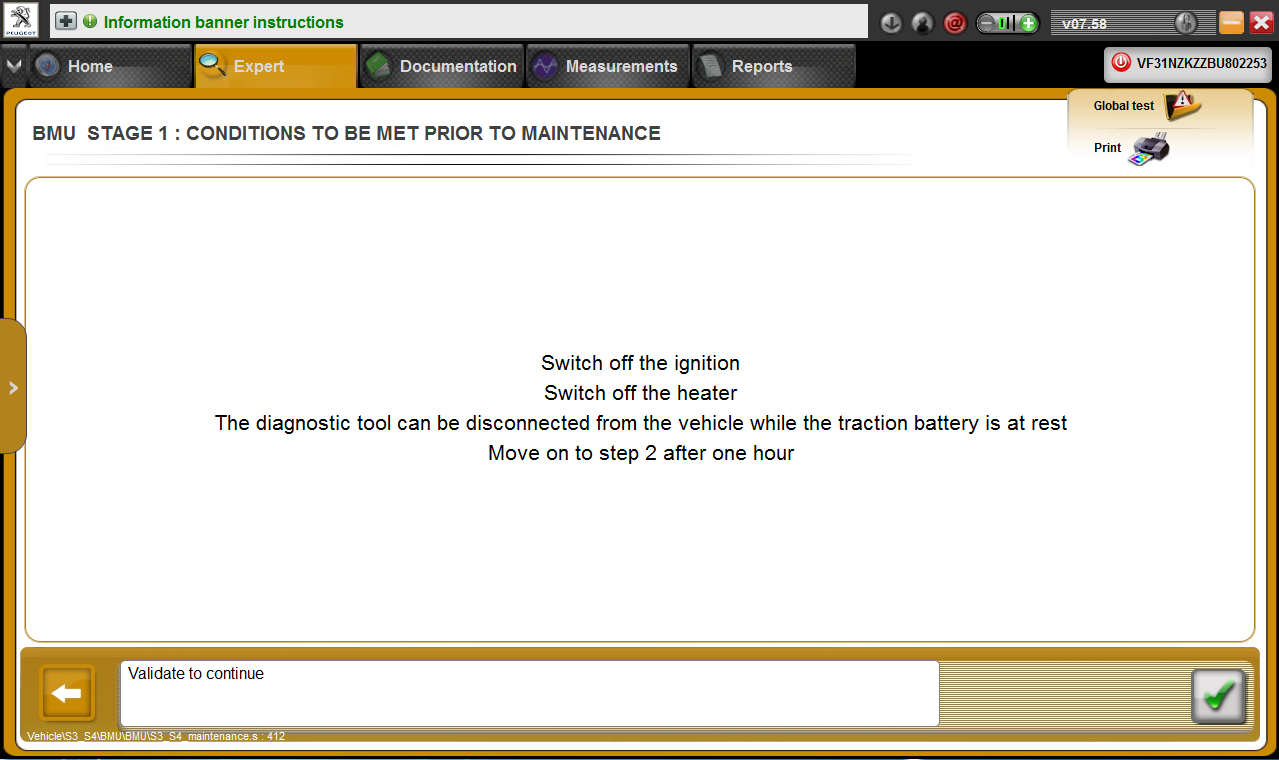
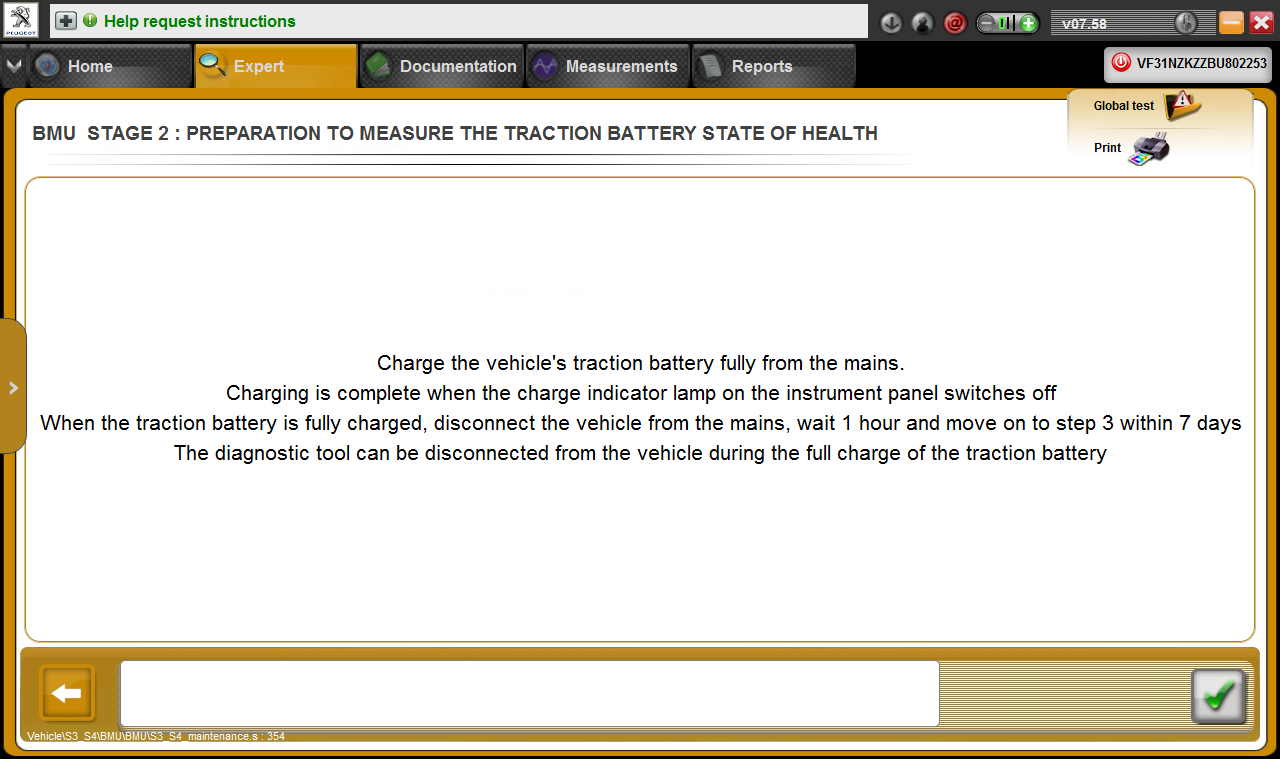
It's a little bit confusing but in essence it goes like this:
1) Discharge the battery to about 5 bars before the test (which I did by driving, as using the heater as recommended was taking too long)
The first step (not show in my screenshots) "configures" something in the BMS before the test proper starts. It seems to change the estimated Ah capacity to a "conservative" figure of 32.5Ah - as soon as I ran this first step I noticed the battery gauge jumped up from 4 bars to 6 bars, and the reported Ah capacity dropped instantly from 37.6Ah to 32.5Ah.
So if you only perform step 1 and don't complete the rest of the calibration process you'll end up with an unrealistically low Ah figure and range estimate!
2) Run the heater until the lowest cell voltage is 3.750 to 3.775 volts. It the allows you to continue. The next step tells you you must wait for at least an hour with the key off.
3) Continuing to the next step tells you to plug the car in and let it charge to 100%. Interestingly during this stage because the Ah figure is artificially low it actually charged to an indicated raw charge of 108% in Diagbox...
4) After it's fully charged you run step 3, and at that point (not before) the Ah figure and range remaining are updated - the Ah figure changed from 32.5Ah up to 36.2Ah, and RR changed from 56 miles to 62 miles. (Keeping in mind recent driving was fast driving to drain the battery quickly before the test)
Reported raw charge dropped from 108% to 98.5%, which is what it normally shows for a full charge.
So after this long drawn out calibration process I only succeeded in making the reading drop even further from 37.6Ah to 36.2Ah!
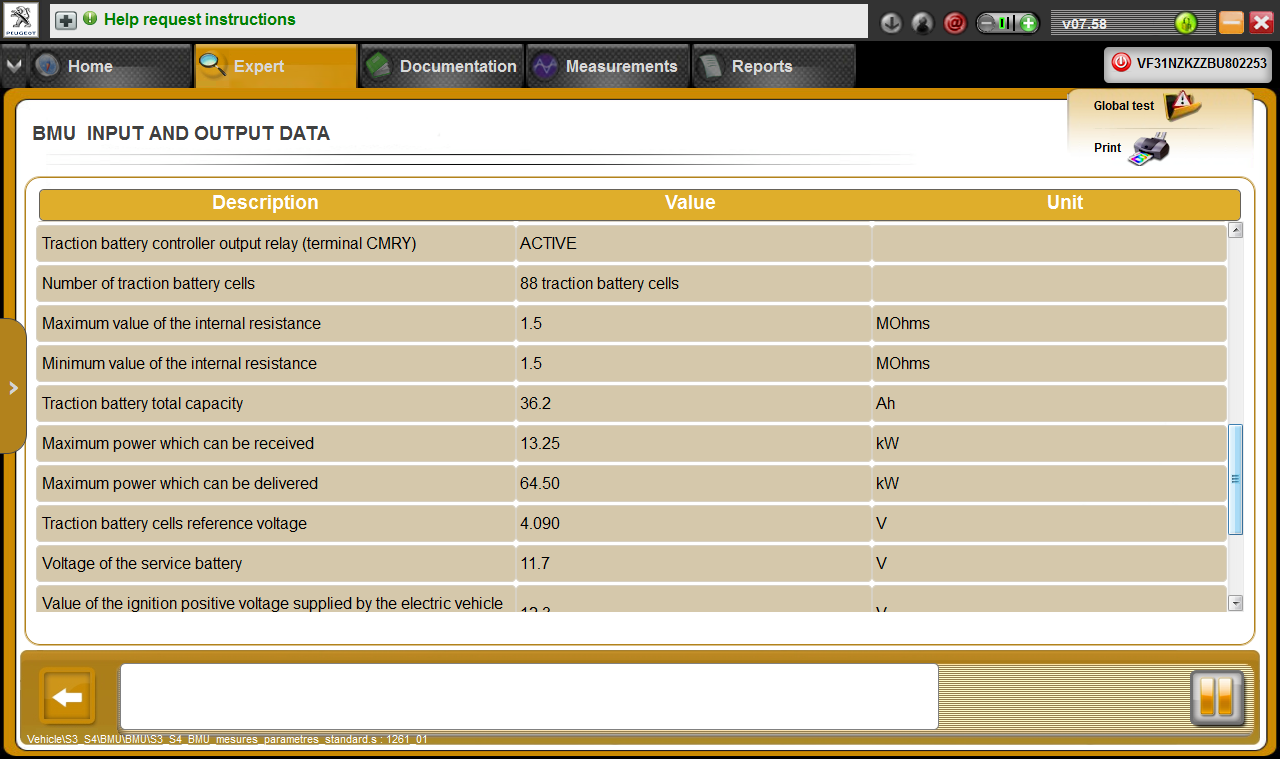
At this point I thought I would disconnect the 12v battery for 10 minutes to reboot all the ECU's - this resulted in the range remaining figure going up from 62 miles to 67, however the Ah figure dropped a fraction to 36.1Ah. So I assume that all that changed with the 12v battery disconnected is that the "recent miles/kWh" estimate changed back to some default estimate that is higher than my recent fast driving.
If I plug the current 36.1Ah figure into my excel graph the situation looks a lot worse than before, and worryingly so:

Something that has me puzzled is that the current Ah figure of 36.1Ah differs significantly from the saved test results from the battery calibration on the "capacity after maintenance" screen of the BMS, which appears to keep a permanent record of the results of the last several battery calibration maintenance sessions:
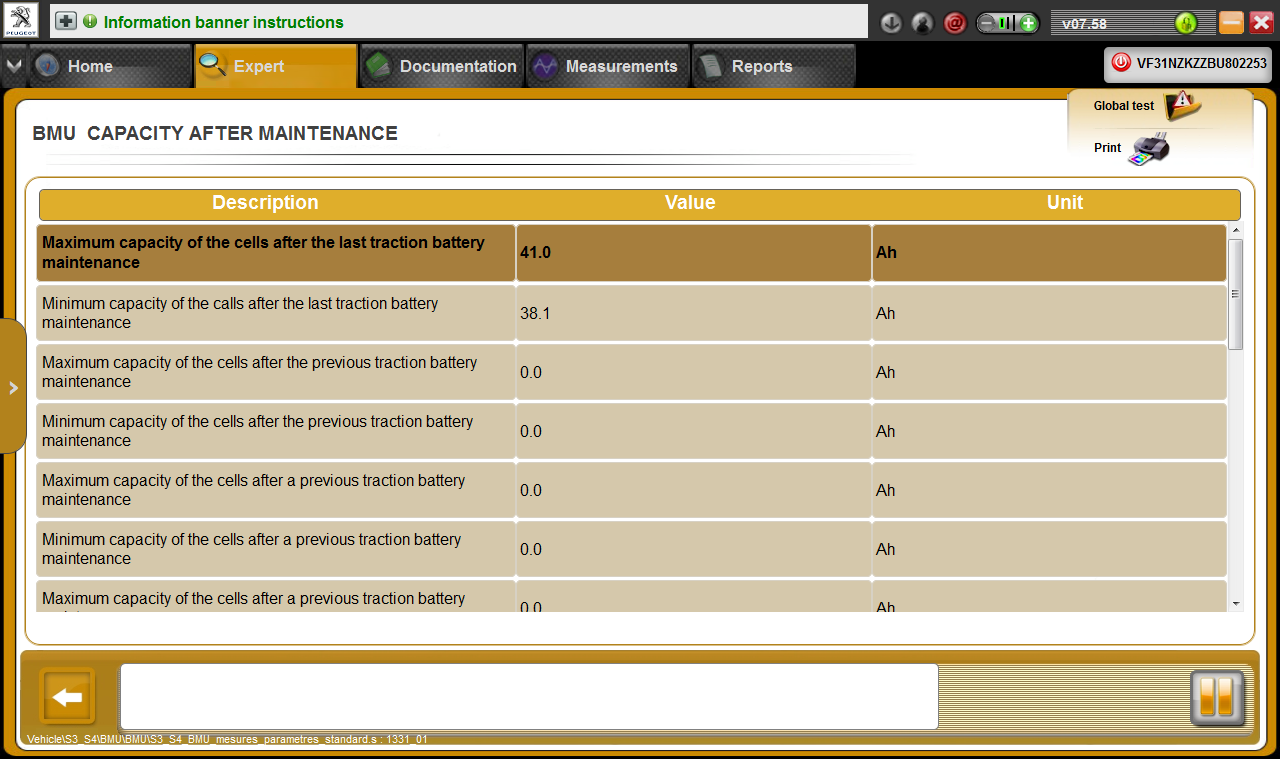
Two interesting things of note from this page - the first is that before I ran the calibration all fields were zero, which I think means that the dealer has never run a battery calibration in the life of the car, despite it apparently being part of the yearly or bi-yearly maintenance schedule... :roll:
The second is that if I read it right, it is saying that the result of the test is that the best cell has a capacity left of 41Ah and the worst 38.1Ah. Although 38.1Ah is still a bit lower than I would have liked to have seen from 38.9 in 3 months, it's a reasonable and believable figure. So how can the worst cell have measured 38.1Ah and yet the figure used in the BMS for range estimation is now 36.1Ah ?
Doesn't make any sense to me... :?
There is another section that purports to show the Ah capacity of every individual cell - which has always said 0 for all cells. I was hoping that the results of the calibration would appear here, but nope - the battery capacity of all the individual cells is still listed as 0 Ah... shame.
So do I have a faulty cell ? I've read most of the threads about people having faulty cells at around 40,000 miles, well guess what, mine seems to have suddenly lost capacity around 40k miles as well... And it looks like there might be an imbalance of one cell - but it will be hard to tell for sure until I have Canion monitoring as Diagbox is too clumsy to view the data in an easy to absorb graphical form and isn't usable while the car is driving.
I recently got hold of an Android tablet and have had an OBDLink LX on order for about a week so I can more easily monitor the battery and general functioning of the car. It hasn't arrived yet but should do this week.
As I haven't checked the Ah figure for 3 months with Diagbox I thought I would today, before my adaptor for Canion arrived - I kind of wish I hadn't! :x There has been a steep decline in reported capacity since January:
The last reading in January was 38.9Ah now in April 3 months and about 3000 miles later it is 37.6Ah. Prior to this it was dropping about 0.1Ah per 1000 miles, now it has dropped 1.3Ah in 3 months...
While the battery was at about 4 bars I checked the cell voltages - which is a lot more cumbersome than using Canion, I did find Cell A in group 4 was averaging 10-15mV less than it's neighbour cells:
During charging this difference went away as the battery got above 50% or so. I didn't notice any other obvious imbalances in other groups. Obviously any cell imbalances at different states of charge will be much easier to see on Canion's graph so its rather fortuitous that I will have that up and running soon.
I decided that now might be the time to try the battery calibration process in Diagbox. The process is a rather byzantine, manual process compared to the one I've seen described for the MUT tester, here are some of the screens from it during the process, which took over 12 hours in total:
It's a little bit confusing but in essence it goes like this:
1) Discharge the battery to about 5 bars before the test (which I did by driving, as using the heater as recommended was taking too long)
The first step (not show in my screenshots) "configures" something in the BMS before the test proper starts. It seems to change the estimated Ah capacity to a "conservative" figure of 32.5Ah - as soon as I ran this first step I noticed the battery gauge jumped up from 4 bars to 6 bars, and the reported Ah capacity dropped instantly from 37.6Ah to 32.5Ah.
So if you only perform step 1 and don't complete the rest of the calibration process you'll end up with an unrealistically low Ah figure and range estimate!
2) Run the heater until the lowest cell voltage is 3.750 to 3.775 volts. It the allows you to continue. The next step tells you you must wait for at least an hour with the key off.
3) Continuing to the next step tells you to plug the car in and let it charge to 100%. Interestingly during this stage because the Ah figure is artificially low it actually charged to an indicated raw charge of 108% in Diagbox...
4) After it's fully charged you run step 3, and at that point (not before) the Ah figure and range remaining are updated - the Ah figure changed from 32.5Ah up to 36.2Ah, and RR changed from 56 miles to 62 miles. (Keeping in mind recent driving was fast driving to drain the battery quickly before the test)
Reported raw charge dropped from 108% to 98.5%, which is what it normally shows for a full charge.
So after this long drawn out calibration process I only succeeded in making the reading drop even further from 37.6Ah to 36.2Ah!
At this point I thought I would disconnect the 12v battery for 10 minutes to reboot all the ECU's - this resulted in the range remaining figure going up from 62 miles to 67, however the Ah figure dropped a fraction to 36.1Ah. So I assume that all that changed with the 12v battery disconnected is that the "recent miles/kWh" estimate changed back to some default estimate that is higher than my recent fast driving.
If I plug the current 36.1Ah figure into my excel graph the situation looks a lot worse than before, and worryingly so:
Something that has me puzzled is that the current Ah figure of 36.1Ah differs significantly from the saved test results from the battery calibration on the "capacity after maintenance" screen of the BMS, which appears to keep a permanent record of the results of the last several battery calibration maintenance sessions:
Two interesting things of note from this page - the first is that before I ran the calibration all fields were zero, which I think means that the dealer has never run a battery calibration in the life of the car, despite it apparently being part of the yearly or bi-yearly maintenance schedule... :roll:
The second is that if I read it right, it is saying that the result of the test is that the best cell has a capacity left of 41Ah and the worst 38.1Ah. Although 38.1Ah is still a bit lower than I would have liked to have seen from 38.9 in 3 months, it's a reasonable and believable figure. So how can the worst cell have measured 38.1Ah and yet the figure used in the BMS for range estimation is now 36.1Ah ?
Doesn't make any sense to me... :?
There is another section that purports to show the Ah capacity of every individual cell - which has always said 0 for all cells. I was hoping that the results of the calibration would appear here, but nope - the battery capacity of all the individual cells is still listed as 0 Ah... shame.
So do I have a faulty cell ? I've read most of the threads about people having faulty cells at around 40,000 miles, well guess what, mine seems to have suddenly lost capacity around 40k miles as well... And it looks like there might be an imbalance of one cell - but it will be hard to tell for sure until I have Canion monitoring as Diagbox is too clumsy to view the data in an easy to absorb graphical form and isn't usable while the car is driving.


































